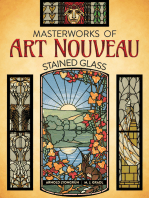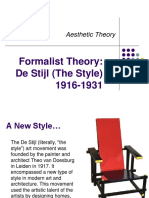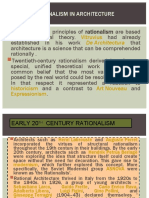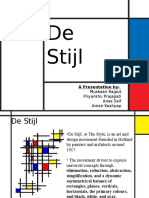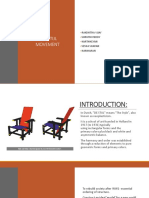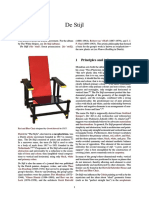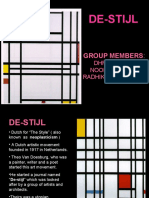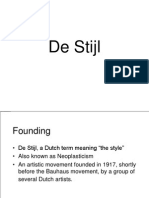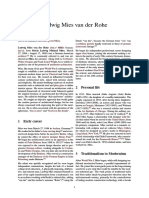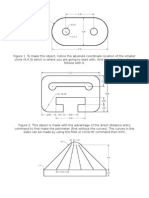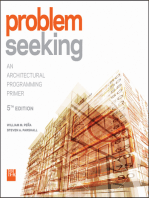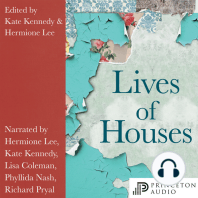Professional Documents
Culture Documents
Gerrit Thomas Rietveld
Uploaded by
Cuculina4Original Description:
Copyright
Available Formats
Share this document
Did you find this document useful?
Is this content inappropriate?
Report this DocumentCopyright:
Available Formats
Gerrit Thomas Rietveld
Uploaded by
Cuculina4Copyright:
Available Formats
Gerrit Thomas Rietveld
Gerrit Thomas Rietveld was a young rationalist artist, active and committed, who joined the De Stijl movement. Considered as a luminary artist of this style he created ground-breaking works both in architecture and furniture design. The The Stijl movement tended to translate and compose in ideology the theme of dynamic breakdown and decomposition that had already been expressed in cubist painting.
He seemed to possess two personalities, each so distinct that one might take his work to be that of more than one artist. The first personality is that seen in the craftsman cabinet-maker working in a primordial idiom, re-inventing chairs and other furniture as if no one had ever built them before, and following a structural code all of his own; the second is that of the architect working with elegant formulas, determined to drive home the rationalist and neoplastic message in the context of European architecture.
G.T.Rietveld Schroder-house
Gerrit Rietveld meant to attain a universal modernization of arts by means of a geometrically reduced and purely forms, principles that could be applied to all objects of utility. Vertical and horizontal lines and a pure black and white as well as the basic colours that dominated the design ideas of De Stijl, were combined in his masterpiece "Rot-Blau-Stuhl" (Red-Blue-Chair) from 1918. This work is a redefinition of seating furniture: the chair is an ingenious yet simple combination of basic rectangular shapes, coloured in red, blue, yellow and black, that seize the room. Colours had a symbolical meaning: yellow represented the power source of the Sun, blue stood for the horizontal lines essential to architecture, while red suggested the partnership between the two.
G.T.Rietveld Mondial Chair
The impact of Rietveld's designs galvanized a renaissance that would influence the worlds of architecture and design for decades to come.
G.T.Rietveld Side Table
You might also like
- Gerrit Rietveld ReportDocument1 pageGerrit Rietveld ReportFaith UrriquiaNo ratings yet
- De Stijl - Abstraction in ArchitectureDocument10 pagesDe Stijl - Abstraction in ArchitectureShubham Arun KawareNo ratings yet
- Gerrit Rietveld: - Some Works - Design Philosophy - Project-Schroder HouseDocument19 pagesGerrit Rietveld: - Some Works - Design Philosophy - Project-Schroder HouseSaurabh DeyNo ratings yet
- Rietveld Schroder House Classicism and TDocument14 pagesRietveld Schroder House Classicism and Tlouimane51No ratings yet
- Formalism de StijlDocument8 pagesFormalism de StijlRahul TomarNo ratings yet
- Rationalist-Expressionist-de StijlDocument15 pagesRationalist-Expressionist-de Stijlsteen cahillNo ratings yet
- De StijlDocument22 pagesDe StijlMuskaan Rajput100% (2)
- De StijlDocument22 pagesDe StijlMuskaan RajputNo ratings yet
- Rietveld Works ARCHITECTDocument14 pagesRietveld Works ARCHITECTrakesh rajuNo ratings yet
- De Stijl MovementDocument12 pagesDe Stijl MovementDinsha DineshNo ratings yet
- De StijlDocument14 pagesDe Stijlsrividhya raghavanNo ratings yet
- 10.de StijlDocument11 pages10.de StijlrameshNo ratings yet
- Gerrit Reitveld: Architect and Furniture DesignerDocument22 pagesGerrit Reitveld: Architect and Furniture DesignerDivyashree MathiyazhaganNo ratings yet
- Dutch Neoplasticism Art Movement Leiden: Vedant Hedau 1900701036Document3 pagesDutch Neoplasticism Art Movement Leiden: Vedant Hedau 1900701036Vedant HedauNo ratings yet
- 06-Desijl and BauhausDocument63 pages06-Desijl and BauhausGgf FggNo ratings yet
- Lecture 2 de Stijl Movement - FinalDocument14 pagesLecture 2 de Stijl Movement - FinalYashraj GautamNo ratings yet
- De StijlDocument22 pagesDe StijlSowmi MaheNo ratings yet
- Design Activity 2Document10 pagesDesign Activity 2comenius_aengNo ratings yet
- Icntad Full Paper 2020Document5 pagesIcntad Full Paper 2020Faisal KhanNo ratings yet
- De Stijl MovementDocument13 pagesDe Stijl MovementBahaa Abou MjahedNo ratings yet
- De Stijl MovementDocument13 pagesDe Stijl MovementBahaa Abou MjahedNo ratings yet
- De Stijl The Dutch PhaseDocument21 pagesDe Stijl The Dutch Phaseفرح العجميNo ratings yet
- Gerrit Rietveld1234Document22 pagesGerrit Rietveld1234Sowmi MaheNo ratings yet
- De StijlDocument7 pagesDe StijlAhmed SaberNo ratings yet
- Rietveld Schroederhuis Rietveld Schroeder House PDFDocument117 pagesRietveld Schroederhuis Rietveld Schroeder House PDFAndres Felipe Corredor FonsecaNo ratings yet
- De Stijl PresentationDocument34 pagesDe Stijl PresentationSaurav ShresthaNo ratings yet
- CCCCCCCCCCCCC C C C CCCCCCCC C: CC CCCCCCCCCCCCDocument6 pagesCCCCCCCCCCCCC C C C CCCCCCCC C: CC CCCCCCCCCCCCRamsrajNo ratings yet
- De Stijl - Influences (Mind Map)Document2 pagesDe Stijl - Influences (Mind Map)mycurlycuesNo ratings yet
- Rietveld - MondrianDocument17 pagesRietveld - MondrianCristina Rucareanu50% (2)
- De StijlDocument8 pagesDe StijlDavy NabucoNo ratings yet
- History of Architecture 2 Ar. Diane A. JoseDocument13 pagesHistory of Architecture 2 Ar. Diane A. JoseJohn Roldan BuhayNo ratings yet
- De-Stijl ArchitectureDocument25 pagesDe-Stijl Architecturedplpthk1502No ratings yet
- De StijlDocument5 pagesDe StijlhellishlyNo ratings yet
- Architecture Style - de StijlDocument8 pagesArchitecture Style - de StijlShweta SainiNo ratings yet
- De StijlDocument26 pagesDe StijlPia TiamzonNo ratings yet
- De Stijl: History of Architecture - 3Document9 pagesDe Stijl: History of Architecture - 3ShabnamNo ratings yet
- De Stijl PresentationDocument28 pagesDe Stijl Presentationcbrunet22046100% (2)
- Schroder House - PDFDocument32 pagesSchroder House - PDFAISHORYA SATYALNo ratings yet
- Modern Architecture - DestijlDocument9 pagesModern Architecture - DestijlPreethi NandagopalNo ratings yet
- de StijlDocument22 pagesde StijlHoàng YếnNo ratings yet
- Ent - Tri StoliceDocument6 pagesEnt - Tri StoliceNađaGorančićNo ratings yet
- De Stijl: NeoplasticismDocument55 pagesDe Stijl: NeoplasticismIna AlexandraNo ratings yet
- DestijlDocument8 pagesDestijlindrapriyaNo ratings yet
- Objets BrutsDocument101 pagesObjets BrutsGaston GastonNo ratings yet
- 5 Rowhouses by J.J.P. Oud in Weissenhof 5 Rowhouses by J.J.P. Oud in Weissenhof 5 Rowhouses by J.J.P. Oud in WeissenhofDocument8 pages5 Rowhouses by J.J.P. Oud in Weissenhof 5 Rowhouses by J.J.P. Oud in Weissenhof 5 Rowhouses by J.J.P. Oud in WeissenhofClaudiaBenhaimNo ratings yet
- F07 Cuellar PaperDocument14 pagesF07 Cuellar PaperRohan KulkarniNo ratings yet
- Ar. Gerrit Rietveld TimelineDocument2 pagesAr. Gerrit Rietveld TimelineAbhishek Agrawal50% (2)
- Richard Meier EssayDocument5 pagesRichard Meier EssaySmaranda CiubotaruNo ratings yet
- The Modern Movement HistoryDocument61 pagesThe Modern Movement HistoryRaja A. AlnasrullahNo ratings yet
- The Bibendum Chair': Designed by Eileen GrayDocument6 pagesThe Bibendum Chair': Designed by Eileen GrayDiana VoLoveiNo ratings yet
- De StijlDocument17 pagesDe StijlMilenaRomeroNo ratings yet
- MINIMALISM & de StijlDocument8 pagesMINIMALISM & de StijlHinalNo ratings yet
- De StijlDocument7 pagesDe StijlFatima ZehraNo ratings yet
- De Stijl Revised PDFDocument7 pagesDe Stijl Revised PDFsuresh pvNo ratings yet
- De Stijl Revised PDFDocument7 pagesDe Stijl Revised PDFsuresh pv100% (1)
- Ludwig Mies Van Der Rohe, The LifeDocument13 pagesLudwig Mies Van Der Rohe, The LifeBrunoNo ratings yet
- Moma Catalogue 1798Document17 pagesMoma Catalogue 1798Lucas Nahuel AntiforaNo ratings yet
- History of Architecture2Document41 pagesHistory of Architecture2praveenhansraj100% (1)
- De StiljDocument6 pagesDe StiljAleksandras ČapasNo ratings yet
- Undesireable ParticlesDocument12 pagesUndesireable ParticlesCuculina4No ratings yet
- Desene Si Scheme CinematiceDocument9 pagesDesene Si Scheme CinematiceCuculina4No ratings yet
- Continuously Variable TransmissionsDocument14 pagesContinuously Variable TransmissionsCuculina4No ratings yet
- SSP 237 d2Document16 pagesSSP 237 d2Cuculina4No ratings yet
- Autocad 3D and 2D Practice ActivitiesDocument19 pagesAutocad 3D and 2D Practice ActivitiesJed Tedor88% (33)
- Lab.4 WaterDocument3 pagesLab.4 WaterCuculina4No ratings yet
- Vehicle CollisionDocument56 pagesVehicle CollisionCuculina4No ratings yet
- Mock-Up PlanDocument1 pageMock-Up PlanCuculina4No ratings yet
- Aesthetic Intentions in Product Design: Market Driven or Alternative FormDocument13 pagesAesthetic Intentions in Product Design: Market Driven or Alternative FormCuculina4No ratings yet
- Applications: Laplace TransformDocument1 pageApplications: Laplace TransformCuculina4No ratings yet
- History and Culture of DesignDocument1 pageHistory and Culture of DesignCuculina4No ratings yet
- Marcel BreuerDocument1 pageMarcel BreuerCuculina4No ratings yet
- House Rules: How to Decorate for Every Home, Style, and BudgetFrom EverandHouse Rules: How to Decorate for Every Home, Style, and BudgetNo ratings yet
- Biophilic Design: The Theory, Science and Practice of Bringing Buildings to LifeFrom EverandBiophilic Design: The Theory, Science and Practice of Bringing Buildings to LifeRating: 4.5 out of 5 stars4.5/5 (2)
- The Hotel on Place Vendôme: Life, Death, and Betrayal at the Hotel Ritz in ParisFrom EverandThe Hotel on Place Vendôme: Life, Death, and Betrayal at the Hotel Ritz in ParisRating: 3.5 out of 5 stars3.5/5 (49)
- A Place of My Own: The Architecture of DaydreamsFrom EverandA Place of My Own: The Architecture of DaydreamsRating: 4 out of 5 stars4/5 (242)
- Dream Sewing Spaces: Design & Organization for Spaces Large & SmallFrom EverandDream Sewing Spaces: Design & Organization for Spaces Large & SmallRating: 4 out of 5 stars4/5 (24)
- Martha Stewart's Organizing: The Manual for Bringing Order to Your Life, Home & RoutinesFrom EverandMartha Stewart's Organizing: The Manual for Bringing Order to Your Life, Home & RoutinesRating: 4 out of 5 stars4/5 (11)
- Architectural Detailing: Function, Constructibility, AestheticsFrom EverandArchitectural Detailing: Function, Constructibility, AestheticsRating: 5 out of 5 stars5/5 (1)
- The Urban Sketching Handbook: Understanding Perspective: Easy Techniques for Mastering Perspective Drawing on LocationFrom EverandThe Urban Sketching Handbook: Understanding Perspective: Easy Techniques for Mastering Perspective Drawing on LocationRating: 4.5 out of 5 stars4.5/5 (12)
- Fundamentals of Building Construction: Materials and MethodsFrom EverandFundamentals of Building Construction: Materials and MethodsRating: 4 out of 5 stars4/5 (3)
- Building Structures Illustrated: Patterns, Systems, and DesignFrom EverandBuilding Structures Illustrated: Patterns, Systems, and DesignRating: 5 out of 5 stars5/5 (4)
- Big Bim Little Bim: the Practical Approach to Building Information Modeling - Integrated Practice Done the Right Way!From EverandBig Bim Little Bim: the Practical Approach to Building Information Modeling - Integrated Practice Done the Right Way!Rating: 4 out of 5 stars4/5 (4)
- The Pint-Sized Guide to Organizing Your HomeFrom EverandThe Pint-Sized Guide to Organizing Your HomeRating: 4.5 out of 5 stars4.5/5 (2)
- Welcome Home: A Cozy Minimalist Guide to Decorating and Hosting All Year RoundFrom EverandWelcome Home: A Cozy Minimalist Guide to Decorating and Hosting All Year RoundRating: 4.5 out of 5 stars4.5/5 (11)
- Antoni Gaudi and Frank Lloyd Wright: The Lives and Works of the Most Influential Modern ArchitectsFrom EverandAntoni Gaudi and Frank Lloyd Wright: The Lives and Works of the Most Influential Modern ArchitectsRating: 2.5 out of 5 stars2.5/5 (2)
- Loving Yourself: The Mastery of Being Your Own PersonFrom EverandLoving Yourself: The Mastery of Being Your Own PersonRating: 5 out of 5 stars5/5 (2)
- The Bright Ages: A New History of Medieval EuropeFrom EverandThe Bright Ages: A New History of Medieval EuropeRating: 5 out of 5 stars5/5 (1)
- Vastu: The Ultimate Guide to Vastu Shastra and Feng Shui Remedies for Harmonious LivingFrom EverandVastu: The Ultimate Guide to Vastu Shastra and Feng Shui Remedies for Harmonious LivingRating: 4.5 out of 5 stars4.5/5 (41)
- The 99% Invisible City: A Field Guide to the Hidden World of Everyday DesignFrom EverandThe 99% Invisible City: A Field Guide to the Hidden World of Everyday DesignRating: 4.5 out of 5 stars4.5/5 (7)
- Cozy Minimalist Home: More Style, Less StuffFrom EverandCozy Minimalist Home: More Style, Less StuffRating: 4 out of 5 stars4/5 (154)
- Flying Star Feng Shui: Change Your Energy; Change Your LuckFrom EverandFlying Star Feng Shui: Change Your Energy; Change Your LuckRating: 4.5 out of 5 stars4.5/5 (2)
- Extraordinary Projects for Ordinary People: Do-It-Yourself Ideas from the People Who Actually Do ThemFrom EverandExtraordinary Projects for Ordinary People: Do-It-Yourself Ideas from the People Who Actually Do ThemRating: 3.5 out of 5 stars3.5/5 (3)
- Problem Seeking: An Architectural Programming PrimerFrom EverandProblem Seeking: An Architectural Programming PrimerRating: 2 out of 5 stars2/5 (1)
- Solar Power Demystified: The Beginners Guide To Solar Power, Energy Independence And Lower BillsFrom EverandSolar Power Demystified: The Beginners Guide To Solar Power, Energy Independence And Lower BillsRating: 4.5 out of 5 stars4.5/5 (2)
